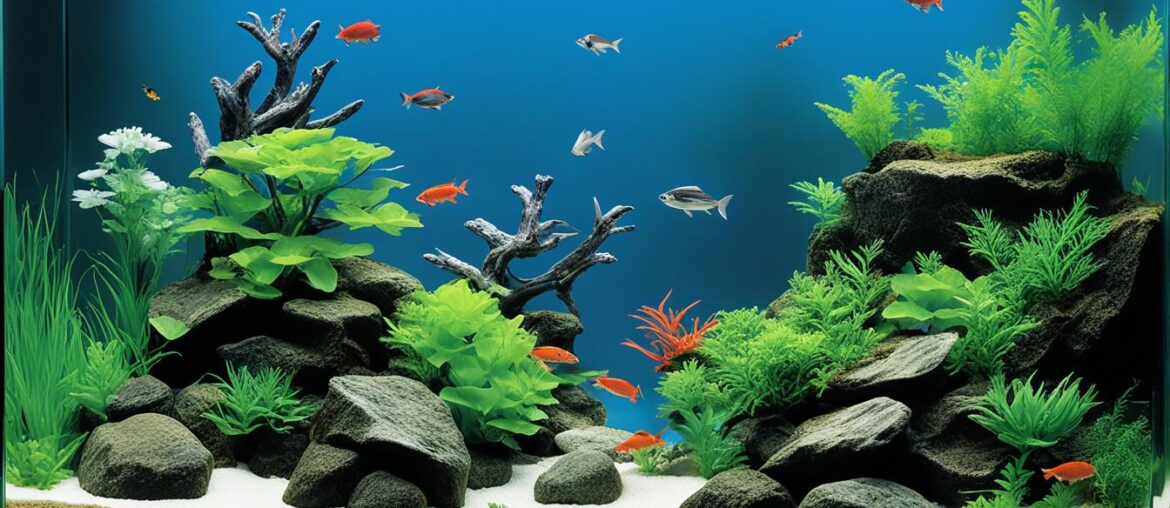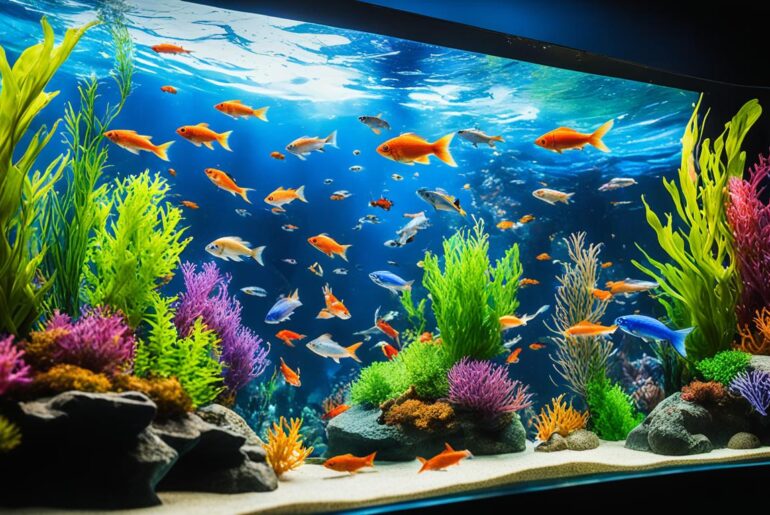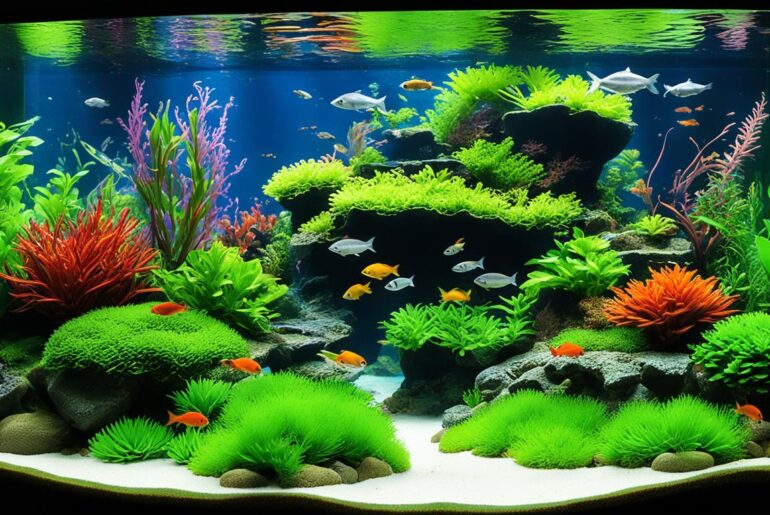As I gaze into my freshwater aquarium, I am instantly transported to a world of tranquility and beauty. The vibrant colors and graceful movements of the fish mesmerize me, offering a sense of calm amidst the chaos of everyday life. But maintaining this underwater paradise requires more than just admiration; it demands dedication and a proper cleaning routine.
Like any living environment, a fish tank needs regular maintenance to thrive. Without proper care, the water quality can deteriorate, leading to stressed and unhealthy fish. I learned this the hard way when I neglected my aquarium for too long. The water became cloudy, and the once vibrant fish appeared dull and lethargic. It was a wake-up call that prompted me to develop a freshwater aquarium cleaning routine that is both effective and manageable.
Let me share with you the 10 steps I’ve discovered to ensure a perfect freshwater aquarium cleaning routine. By following these steps, you can maintain a healthy environment for your fish and enjoy a pristine and captivating underwater world that will bring you endless joy and relaxation.
Key Takeaways:
- Regular aquarium maintenance is essential for the health and appearance of your freshwater aquarium.
- Water changes are the most important aspect of aquarium maintenance, typically done every one to two weeks.
- Observing fish for signs of illness, removing excess food, and monitoring water temperature are crucial daily tasks.
- Performing a thorough weekly cleaning of the tank walls, gravel, and decorations keeps your aquarium clean and algae-free.
- Monthly water quality testing helps ensure the appropriate balance of pH, ammonia, nitrite, nitrate, and phosphate levels.
Setting Up a Daily Aquarium Maintenance Routine
Proper daily maintenance is crucial for the health and well-being of your freshwater aquarium and its inhabitants. By following a consistent routine, you can ensure that your aquarium remains clean, well-functioning, and beneficial to fish health. Here are the essential tasks to include in your daily aquarium maintenance:
Check Equipment Functionality
Regularly inspect your aquarium equipment, such as filters, pumps, and lights. Any malfunctioning equipment should be addressed immediately to prevent potential issues. Keep an eye out for any unusual noises, leaks, or decreased performance that may indicate a problem. Prompt maintenance and repairs will contribute to the overall health and stability of your aquarium.
Observe Fish Health
Daily observation of your fish is crucial for early identification of any signs of illness or stress. Watch for abnormal behavior, such as excessive hiding, loss of appetite, or changes in swimming patterns. If you notice any concerning symptoms, take immediate action to prevent further deterioration. Additionally, conduct regular water tests to ensure its quality and eliminate water-related health factors as the cause of any fish issues.
Remove Excess Food
Overfeeding can lead to poor water quality and create an unhealthy environment for your fish. Remove any uneaten food from the aquarium promptly to avoid decomposition and potential water quality issues. A clean tank will provide a safer and more sustainable habitat for your fish to thrive in.
Top Off with Treated Water
Regularly monitor the water level in your aquarium and top it off with treated water as needed. This helps maintain a stable environment for your fish and compensates for any evaporation. Use an appropriate water conditioner to eliminate harmful substances and ensure the water is safe and suitable for your fish.
Monitor Water Temperature
Check the water temperature daily to ensure it remains within the optimal range for your fish species. Sudden temperature fluctuations can stress your fish and compromise their health. Use a reliable aquarium thermometer to monitor the temperature and make any necessary adjustments to maintain a stable and comfortable environment.
By incorporating these daily maintenance tasks into your routine, you’ll create a healthier, more vibrant, and more enjoyable freshwater aquarium for both you and your fish.
Performing a Weekly Fish Tank Cleaning
Performing regular weekly cleaning is essential for maintaining a clean and healthy fish tank. This not only ensures the well-being of your fish but also enhances the overall aesthetic appeal of your aquarium. In this section, I will guide you through the step-by-step process of deep cleaning your fish tank, using the necessary cleaning supplies and techniques to achieve the best results.
Gather Your Cleaning Supplies
Before you begin, gather the following cleaning supplies:
- Algae scrubber
- Gravel vacuum
- Filter brush
- Acrylic-safe cleaner
These specialized tools will help you effectively remove debris, grime, and algae from your fish tank.
The Step-by-Step Cleaning Process
- Start by removing a portion of the water from your aquarium. Aim to remove around 20-25% of the water to avoid a drastic change in the tank’s ecosystem.
- Next, carefully remove any non-living decor, such as rocks or artificial plants, from the tank. Rinse them with treated water to remove any accumulated dirt or algae.
- Using an algae scrubber, gently scrub the glass walls of the tank to remove any algae buildup. Take care not to scratch the glass.
- Now, it’s time to vacuum the gravel. Use a gravel vacuum to remove debris and waste that may have settled at the bottom of the tank. Move the vacuum across the gravel, making sure to cover the entire surface area.
- Finally, lightly rinse the filter media to remove any trapped particles. Be cautious not to disturb the beneficial bacteria on the filter media as it plays a crucial role in maintaining the water quality.
Remember to always rinse your cleaning supplies with treated water to ensure they are free from any harmful substances that could harm your fish. Additionally, avoid using soap or any harsh chemicals when cleaning your fish tank, as they can be toxic to the delicate aquatic ecosystem.
By following these weekly cleaning routines, you can significantly improve the cleanliness and health of your fish tank. A visually appealing aquarium with clean and clear water will create a serene and enjoyable environment for both you and your fish.
Remember to refer to the table below for a quick recap of the weekly fish tank cleaning process:
| Step | Description |
|---|---|
| 1 | Remove a portion of the water from the tank. |
| 2 | Rinse and scrub non-living decor. |
| 3 | Scrub the glass walls using an algae scrubber. |
| 4 | Vacuum the gravel using a gravel vacuum. |
| 5 | Lightly rinse the filter media. |
A clean and well-maintained fish tank not only provides a healthy habitat for your fish but also creates a beautiful centerpiece in your home. So, invest time in performing weekly maintenance to ensure the long-term success of your aquarium.
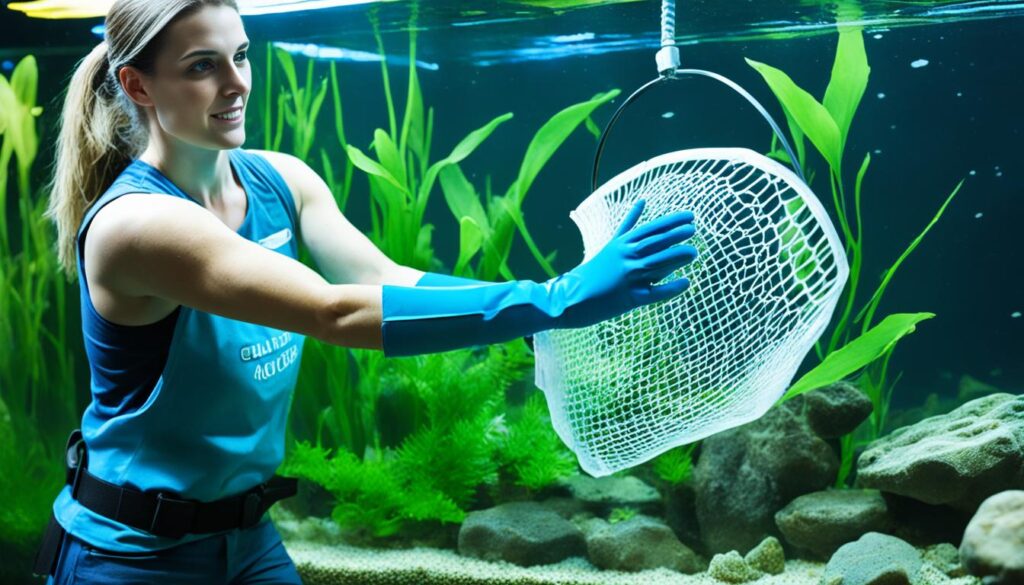
Monthly Water Quality Testing and Maintenance
Regular water quality testing is essential to ensure the health and well-being of your fish and the overall balance of your aquarium. By monitoring the pH, ammonia, nitrite, nitrate, and phosphate levels, you can identify any imbalances and take corrective actions to maintain a healthy environment for your aquatic friends.
Testing kits are available to measure these parameters accurately. With the results in hand, you can make informed decisions about the necessary steps to address any issues. For example, if the pH levels are too high or too low, specific substances can be added to the tank to adjust and stabilize the pH within the appropriate range.
To prevent stress to your fish, it is important to make any changes to the water gradually. This includes adjusting the pH or replacing large amounts of water. Sudden changes can disrupt the delicate balance of your aquarium and potentially harm the fish.
Water Quality Parameters:
| Parameter | Ideal Range | Testing Method |
|---|---|---|
| pH | 6.5 – 7.5 | pH Test Kit |
| Ammonia | 0 ppm | Ammonia Test Kit |
| Nitrite | 0 ppm | Nitrite Test Kit |
| Nitrate | 10 – 20 ppm | Nitrate Test Kit |
| Phosphate | 0.1 – 1.0 ppm | Phosphate Test Kit |
By diligently testing and maintaining the water quality in your aquarium on a monthly basis, you can ensure the optimal health and well-being of your fish, as well as the overall stability of your aquatic ecosystem.
Acclimating Fish to the Aquarium
Acclimating fish to their new environment is a crucial step in ensuring their well-being and reducing stress. This process involves gradually adjusting the fish to the water chemistry and temperature of the aquarium. By following the proper acclimation techniques, you can give your fish the best chance for a smooth transition.
Testing Water Chemistry
Before introducing your fish to the aquarium, it is recommended to test the water chemistry to ensure that it matches the appropriate levels for the specific fish species. This includes parameters such as pH, ammonia, nitrite, nitrate, and water hardness. Testing kits are readily available and provide accurate readings for these essential water parameters.
Slow Temperature Adjustment
To help fish acclimate to the water temperature of the aquarium, it’s important to float their sealed bag in the tank for about 15 to 20 minutes. This allows the temperature inside the bag to gradually adjust to the temperature of the aquarium. Always make sure the bag is securely closed to avoid any escapes or water contamination. Take your time during this process to ensure a smooth transition for your fish.
Gradual Water Mixing
After the temperature acclimation, the next step is to gradually mix small amounts of the aquarium water into the fish bag at regular intervals. This helps the fish adjust to the water chemistry slowly. For example, you can add a quarter cup of aquarium water every 10 to 15 minutes over a period of one to two hours. This process allows the fish to become accustomed to the water conditions in the tank without experiencing any sudden changes.
Releasing the Fish
Once the gradual water mixing process is complete, it’s time to release the fish into the aquarium. Carefully use a net to transfer the fish from the bag into the tank. Avoid pouring the bag water directly into the tank, as this can introduce any potential contaminants from the bag. Allow the fish to swim out of the net at their own pace, giving them time to explore their new surroundings.
Remember, the combination of water chemistry and temperature acclimation is crucial for the overall health and well-being of the fish. By following these acclimation techniques, you are creating a smooth transition for your fish and setting them up for a successful life in their new aquarium.
| Acclimating Fish to the Aquarium | |
|---|---|
| 1. Test the water chemistry | Ensure appropriate levels of pH, ammonia, nitrite, nitrate, and water hardness. |
| 2. Gradually adjust the water temperature | Float the sealed fish bag in the aquarium for 15-20 minutes to match the temperature. |
| 3. Mix small amounts of aquarium water | Add quarter cup of aquarium water every 10-15 minutes over 1-2 hours to adjust to water chemistry. |
| 4. Release the fish | Transfer the fish from the bag to the tank using a net and allow them to swim out at their own pace. |
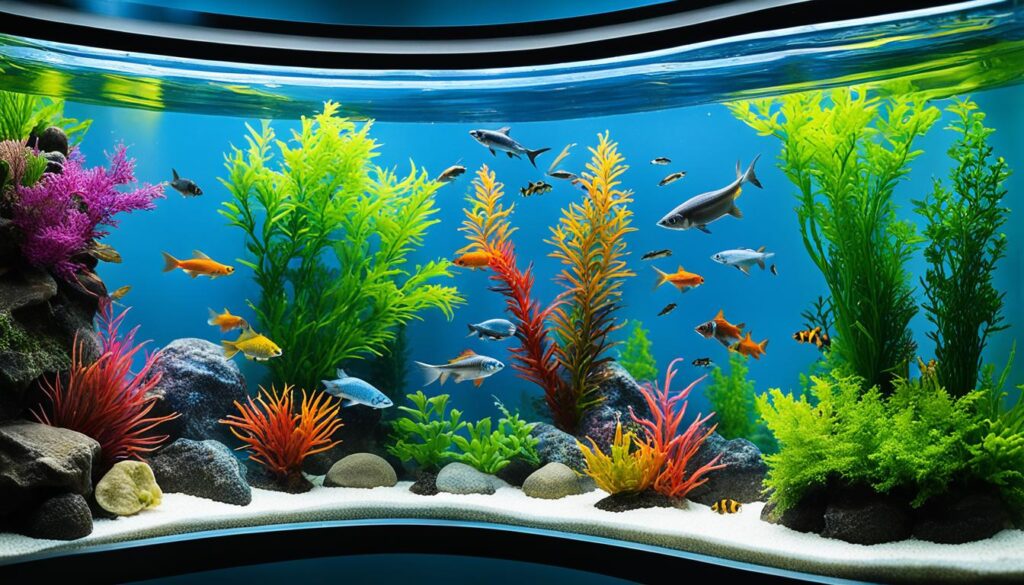
Maintaining Proper Water Parameters
In order to maintain the health and balance of your aquarium, it is crucial to monitor and maintain the proper water parameters. Regular monitoring of pH levels, temperature, ammonia, nitrite, nitrate, phosphate, and water hardness is essential. Let’s take a closer look at each of these parameters and how to keep them in check.
pH Balance
The pH level of your aquarium water is a measure of its acidity or alkalinity. Different fish species require specific pH ranges to thrive. It is important to regularly test and adjust the pH level in your tank. Substances such as crushed coral, limestone, or reverse osmosis water can be used to raise or lower pH levels as needed.
Ammonia, Nitrite, Nitrate, and Phosphate
High levels of ammonia, nitrite, nitrate, and phosphate can be harmful to your fish and contribute to excessive algae growth. Regular water changes, adding beneficial bacteria, and avoiding overfeeding can help maintain these levels within a safe range. Regular water testing is essential to catch any imbalances early and take appropriate corrective actions.
Water Hardness
Water hardness refers to the mineral content, mainly calcium and magnesium, in your aquarium water. Different fish species have different preferences when it comes to water hardness. Monitoring and adjusting water hardness can be done by incorporating reverse osmosis water or using peat moss or pebbles with the filter.
By maintaining proper water parameters, you are providing a healthy and stable environment for your fish to thrive. Regular testing, adjustments, and maintaining a balanced ecosystem will contribute to the overall health and longevity of your aquarium.
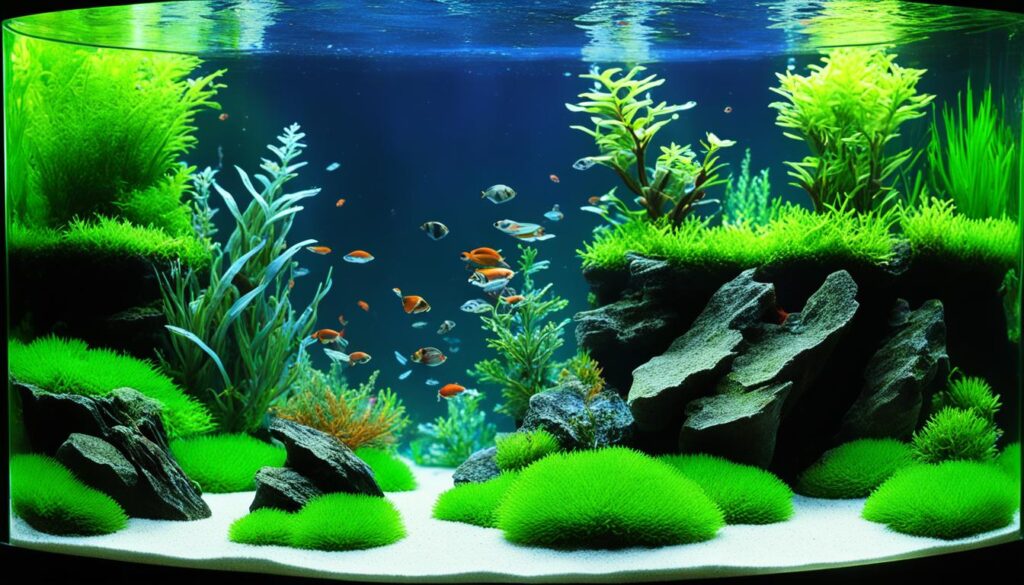
| Water Parameter | Ideal Range |
|---|---|
| pH | Species-specific |
| Ammonia | 0 ppm |
| Nitrite | 0 ppm |
| Nitrate | < 20 ppm |
| Phosphate | < 1 ppm |
| Water Hardness | Species-specific |
Choosing Compatible Fish Species
When stocking a freshwater aquarium, it is crucial to select compatible fish species that can coexist harmoniously. Certain fish species exhibit territorial or aggressive behavior and may not get along well with others. To create a peaceful and balanced community tank, careful consideration of fish compatibility is essential.
Providing adequate space, food, and other necessities for the fish is crucial to their well-being. Researching the compatibility and behavior of different fish species can help prevent aggression and territorial issues, ensuring a thriving aquarium environment. By selecting compatible fish species, you can minimize stress and promote the overall health of your aquatic pets.
Benefits of Choosing Compatible Fish Species
- Promotes a peaceful and harmonious community tank
- Reduces aggression and territorial conflicts
- Helps maintain optimal water quality
- Minimizes stress and promotes fish health
By carefully selecting fish species that are compatible with each other, you can create a visually stunning and serene underwater ecosystem. Compatible fish species will coexist peacefully, reducing the risk of fights and injuries. This compatibility also contributes to maintaining optimal water quality, preventing unnecessary stress and health issues for the fish.
| Fish Species | Behavior | Compatibility |
|---|---|---|
| Neon Tetra | Peaceful, schooling | Compatible with most community fish |
| African Cichlid | Aggressive, territorial | May not be compatible with smaller, peaceful fish |
| Guppy | Peaceful, livebearer | Compatible with most community fish |
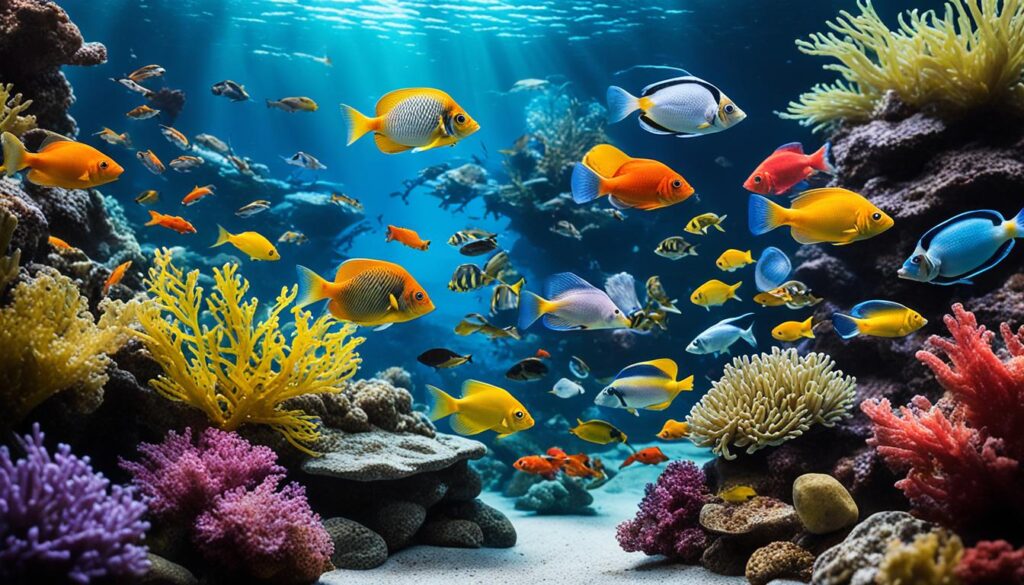
When choosing compatible fish species, consider the temperament, size, and specific needs of each species. Avoid combining aggressive or territorial fish with peaceful or delicate species. Instead, opt for fish that share similar behavioral traits and environmental requirements.
“The key to a successful community tank is choosing fish species that can coexist peacefully.”– Expert Aquarist
By taking the time to research and select compatible fish species, you can create a vibrant and diverse community tank that showcases the beauty of freshwater aquatic life.
Avoiding Overfeeding and Maintaining a Feeding Schedule
Overfeeding fish can have detrimental effects on their health and the overall water quality of the aquarium. It is important to establish and maintain a proper feeding schedule to avoid overfeeding and promote the well-being of your fish.
Feeding fish may seem like a simple task, but it requires careful consideration and moderation. Many fish owners tend to overfeed their fish, thinking that it will keep them healthy and happy. However, excessive feeding can lead to a variety of issues that can negatively impact the aquarium environment.
Overfeeding can result in:
- Poor water quality: Fish produce waste in the form of ammonia, which can accumulate quickly if there is an excess of uneaten food in the tank. This can lead to an imbalance in water parameters and pose a threat to the well-being of the fish.
- Increased waste and debris: Excess food that is left uneaten will decompose and contribute to the build-up of waste and debris in the aquarium. This can result in a dirty and unappealing tank.
- Algae growth: Nutrients from overfeeding, such as phosphates, can fuel the growth of algae in the aquarium. This can lead to unsightly green water and negatively impact the water quality.
To avoid these issues, it is crucial to establish a feeding schedule that suits the specific needs of your fish and the aquarium environment. Here are some guidelines to follow:
- Research the nutritional requirements: Different fish species have different dietary needs. It is important to research and understand the specific feeding requirements of your fish to ensure they receive the proper nutrients.
- Feed appropriate portions: Fish do not require large amounts of food to thrive. It is better to underfeed slightly than to overfeed. Start by offering a small portion and observe if it is consumed within a few minutes. Adjust the amount accordingly to prevent wastage.
- Feed at consistent times: Establish a consistent feeding routine, and feed your fish at the same time each day. This will help prevent overfeeding and ensure that the fish receive the necessary sustenance.
- Avoid excessive treats: While occasional treats can be given to your fish, avoid excessive feeding of treats or live foods, as they are often high in fat and can lead to digestive issues.
By adhering to a feeding schedule and providing an appropriate amount of food, you can prevent overfeeding and maintain optimal water quality in your aquarium. Remember, a balanced and well-maintained environment is essential for the health and longevity of your fish.
Image:

Conclusion
Proper maintenance is the key to ensuring the health and well-being of your freshwater aquarium and the fish that inhabit it. By following a routine cleaning and maintenance schedule, you can create a clean and balanced environment for your fish, promoting their longevity and overall quality of life.
Regular tasks such as performing water changes, monitoring water parameters, observing fish for signs of illness, and maintaining proper feeding practices are essential for maintaining a healthy and thriving aquarium. Regular water changes help to remove harmful substances and maintain water quality, while monitoring water parameters allows you to address any imbalances that could be detrimental to your fish’s health.
Observing your fish for signs of illness or stress is crucial for early detection and prompt treatment. By paying attention to their behavior and appearance, you can address any issues in a timely manner. Additionally, maintaining a proper feeding schedule and avoiding overfeeding can prevent water quality issues and promote the overall well-being of your fish.
Remember, a clean and balanced environment is vital for the health of your fish. By dedicating your time and effort to proper aquarium maintenance, you can create an inviting and thriving habitat that enhances the beauty of your tank while ensuring the well-being of your fish.
FAQ
What is the most important aspect of aquarium maintenance?
Regular water changes are the most important aspect of aquarium maintenance. The frequency and volume of water changes depend on the size of the tank and the number of fish, but a general guideline is to change 15 to 25% of the water every one to two weeks.
What daily tasks should be included in a freshwater aquarium maintenance routine?
Daily tasks for a freshwater aquarium maintenance routine include checking equipment, observing fish for signs of illness, removing excess food, and monitoring water temperature.
How often should I clean my fish tank?
Performing a thorough cleaning of the fish tank should be done on a weekly basis. This involves cleaning the tank walls, gravel, and decorations to remove any buildup of debris, grime, and algae.
What cleaning supplies should I use for my fish tank?
To clean the tank, specialized cleaning supplies such as algae scrubbers, gravel vacuums, filter brushes, and acrylic-safe cleaners can be used.
How often should I test the water in my aquarium?
Regular water quality testing is essential to ensure that the pH, ammonia, nitrite, nitrate, and phosphate levels in the aquarium are within the appropriate range for the fish and plants. Testing kits are available to measure these parameters, and corrective actions can be taken if any levels are found to be out of balance.
How do I acclimate fish to my aquarium?
Acclimating fish to their new environment is crucial to prevent shock and stress. This process involves gradually adjusting the fish to the water chemistry and temperature of the aquarium. Fish should be floated in their sealed bag in the aquarium to acclimate them to the water temperature slowly. Adding small amounts of aquarium water to the bag at regular intervals will help the fish adjust before releasing them into the tank.
What water parameters should I monitor in my aquarium?
Maintaining the proper water parameters is crucial for the health of the fish and the overall balance of the aquarium. pH levels, temperature, ammonia, nitrite, nitrate, phosphate, and water hardness should be monitored regularly.
How do I choose compatible fish species for my aquarium?
When stocking a freshwater aquarium, it is important to choose fish species that are compatible with each other. Some fish species may be territorial or aggressive and may not get along well with certain other species. Researching the compatibility and behavior of different fish species can help prevent aggression and territorial issues.
How often should I feed my fish and how much is enough?
Overfeeding fish can lead to poor water quality, increased waste and debris, and even algae growth. It is important to maintain a consistent feeding schedule and provide an appropriate amount of food for the fish. Fish do not need to be fed large amounts to survive. By avoiding overfeeding and maintaining a feeding schedule, the water quality in the aquarium can be preserved, and the overall health and longevity of the fish can be promoted.
Why is proper aquarium maintenance important?
Proper maintenance of a freshwater aquarium is essential for the health and well-being of the fish and the overall appearance of the tank. Regular tasks such as water changes, monitoring water parameters, observing fish for signs of illness, and maintaining proper feeding practices contribute to maintaining a healthy and thriving aquarium.
